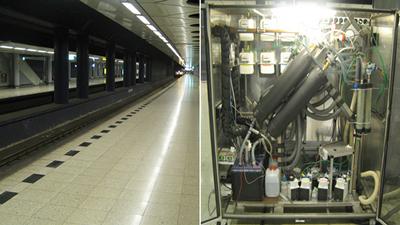

Geochemistry can play a valuable role in the study of environmental health issues. For example, there is growing concern about the impacts of airborne particles on human health, particularly in large urban population centres. There are, however, a multitude of sources of particles in these settings – ranging from natural dust generated during the weathering of rocks to metal-rich particles generated from industrial and transport activities. By determining the detailed chemical composition of particles collected in these environments we are able to fingerprint their sources and, together with our colleagues in the School of Medicine, we are able to isolate the types and amounts of particles that pose a particular risk to human health.
We currently have several areas of research that involve the application of geochemical techniques to health issues. There are main projects concerned with airborne particles. The first involves the study of material collected in underground rail stations, where we have identified abundant metal-rich particles generated by wheel wear on tracks and during overhead electrical discharges. We also have studies examining the composition and effects of dust generated in desert environments that has particular implications for UK ground troops who have spent time in Afghanistan and the Middle East. In addition to these studies of airborne particles, we are also collaborating with orthopaedic surgeons to examine the dissemination and alteration of metal-rich particles within the body generated by degrading surgical implants.
Our expertise in this area comes from the use of our sophisticated and sensitive analytical facilities that allow us to measure the concentrations of virtually any element in very small samples to a high degree of accuracy and precision. We also have a very close collaboration with the School of Medicine that ensures that our studies are fully integrated into holistic studies of the health impacts of metals in the environment.
Visit GSNOCS
Loxham M, Cooper MJ, Gerlofs-Nijland E, Cassee FR, Davies DE, Palmer MR, Teagle DAH 2013. Physicochemical characterization of airborne particulate matter at a mainline underground railway station. Environ. Sci. Technol., doi: 10.1021/es304481m.
The image on the Home page shows the apparatus that was used to collect the particles described in this paper.